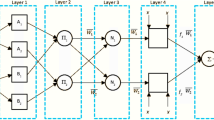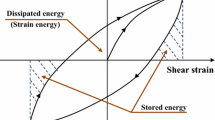Abstract
The determination of liquefaction potential of soils induced by earthquake is a major concern and an essential criterion in the design process of the civil engineering structures. A purely empirical interpretation of the filed case histories relating to liquefaction potential is often not well constrained due to the complication associated with this problem. In this study, an integrated fuzzy neural network model, called Adaptive Neuro-Fuzzy Inference System (ANFIS), is developed for the assessment of liquefaction potential. The model is trained with large databases of liquefaction case histories. Nine parameters such as earthquake magnitude, the water table, the total vertical stress, the effective vertical stress, the depth, the peak acceleration at the ground surface, the cyclic stress ratio, the mean grain size, and the measured cone penetration test tip resistance were used as input parameters. The results revealed that the ANFIS model is a fairly promising approach for the prediction of the soil liquefaction potential and capable of representing the complex relationship between seismic properties of soils and their liquefaction potential.







Similar content being viewed by others
References
Aydin A (2004) Fuzzy set approaches to classification of rock masses. Eng Geol 74(3–4):227–245
Castro G (1987) On the behavior of soils during earthquake-liquefaction. Reprinted from Soil dynamics and liquefaction, Cakmak, A.S., ed., Princeton University, Princeton
Cetin KO, Seed RB, Kiureghian AD, Kohji T et al (2004) Standard penetration test-based probabilistic and deterministic assessment of seismic soil liquefaction potential. J Geotech Geoenviron Eng 130(12):1314–1340
Chiu SL (1994) Fuzzy model identification based on cluster estimation. J Intell Fuzzy Syst 2:267–278
Goh ATC (1994) Seismic liquefaction potential assessed by neural networks. J Geotech Eng ASCE 120(9):1467–1481
Goh ATC (1996) Neural network modeling of CPT seismic liquefaction data. J Geotech Eng ASCE 122(1):70–73
Hanna AM, Ural DN, Saygili G (2007) Evaluation of liquefaction potential of soil deposits using artificial neural networks. Eng Comput 24(1):5–16
Hynes ME, Olsen RS (1999) Influence of confining stress on liquefaction resistance. In: Proceedings of international workshop on physics and mechanics of soil liquefaction, Balkema, Rotterdam (The Netherlands), pp 145–152
Juang CH, Chen CJ (1999) CPT-based liquefaction evaluation using artificial neural networks. Comput-Aided Civ Inf 14(3):221–229
JWWA (Japan Water Works Association) (1998) Seismic design and construction guidelines for water supply facilities. English Translation Edition, Tokyo
Kayadelen C (2011) Soil liquefaction modeling by genetic expression programming and neuro-fuzzy. Expert Syst Appl 38:4080–4087
Liao S, Whitman RV (1986) Overburden correction factors for SPT in sand. J Geotech Eng Div ASCE 112(3):373–377
Mohammad R, Akbar AJ, Orazio G (2010) Evaluation of liquefaction potential based on CPT results using evolutionary polynomial regression. Comput Geotech 37:82–92
Nayak PC, Sudheer KP, Rangan DM, Ramasastri KS (2004) A neuro-fuzzy computing technique for modeling hydrological time series. J Hydrol 291(1–2):52–66
Ni SH, Lu PC, Juang CH (1996) A fuzzy neural network approach to evaluation of slope failure potential. Comput-Aided Civ Inf 11(1):59–66
Romo MP, Garcia SR (2003) Neurofuzzy mapping of CPT values into soil dynamic properties. Soil Dyn Earthq Eng 23(6):473–482
Seed HB (1983) Earthquake-resistant design of earth dams. In: Proceedings of symposium on seismic design of earth dams and caverns, ASCE, New York, pp 41–64
Seed HB, Idriss IM (1971) Simplified procedure for evaluating soil liquefaction potential. J Soil Mech Found Div ASCE 97(9):1249–1273
Seed HB, Tokimatsu K, Harder LF, Chung RM (1985) Influence of SPT procedures in soil liquefaction resistance evaluations. J Geotech Eng 111(12):1425–1445
Shahin MA, Jaksa MB (2005) Neural network prediction of pullout capacity of marquee ground anchors. Comput Geotech 32(3):153–163
Shahin MA, Maier HR, Jaksa MB (2003) Settlement prediction of shallow foundations on granular soils using B-spline neurofuzzy models. Comput Geotech 30(8):637–647
Shibata T, Teparaksa W (1988) Evaluation of liquefaction potentials of soils using cone penetration tests. Soils Found 28(2):49–60
Shuh GC, Ching YL, Chin CW (2008) CPT-based liquefaction assessment by using fuzzy-neural network. J Mar Sci Tech-Taiw 16(2):139–148
Sladen JA, D’ Hollander RD, Krahn J (1985) The liquefaction of sands, a collapse surface approach. Can Geotech J 22(4):564–578
Stark TD, Olson SM (1995) Liquefaction resistance using CPT and field case histories. J Geotech Eng ASCE 121(12):856–869
Sugeno M, Yasukawa T (1993) A fuzzy-logic-based approach to qualitative modeling. IEEE T Fuzzy Syst 1(1):7–31
Takagi T, Sugeno M (1985) Fuzzy identification of systems and its applications to modeling and control. IEEE Trans Syst Man Cybern 15(1):116–131
Youd TL, Idriss IM (1997) Proceedings of the NCEER workshop on evaluation of liquefaction resistance of soils. Technical report NCEER-97-0022, Salt Lake City, Utah
Youd TL, Idriss IM, Andrus RD et al (2001) Liquefaction resistance of soils: summary report from the 1996 NCEER and 1998 NCEER/NSF workshops on evaluation of liquefaction resistance of soils. J Geotech Geoenviron Eng ASCE 127(10):817–833
Author information
Authors and Affiliations
Corresponding author
Rights and permissions
About this article
Cite this article
Xue, X., Yang, X. Application of the adaptive neuro-fuzzy inference system for prediction of soil liquefaction. Nat Hazards 67, 901–917 (2013). https://doi.org/10.1007/s11069-013-0615-0
Received:
Accepted:
Published:
Issue Date:
DOI: https://doi.org/10.1007/s11069-013-0615-0




